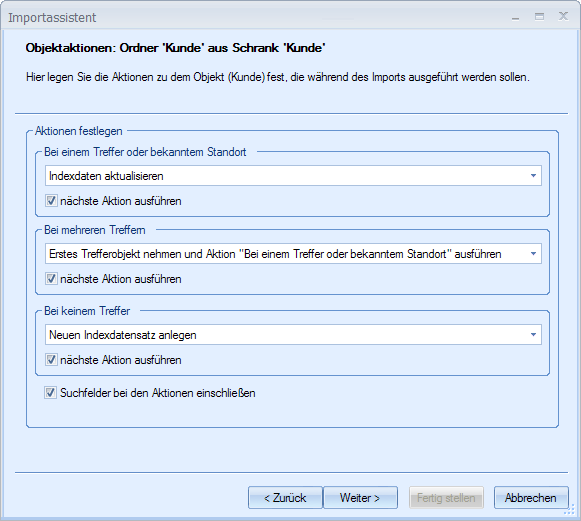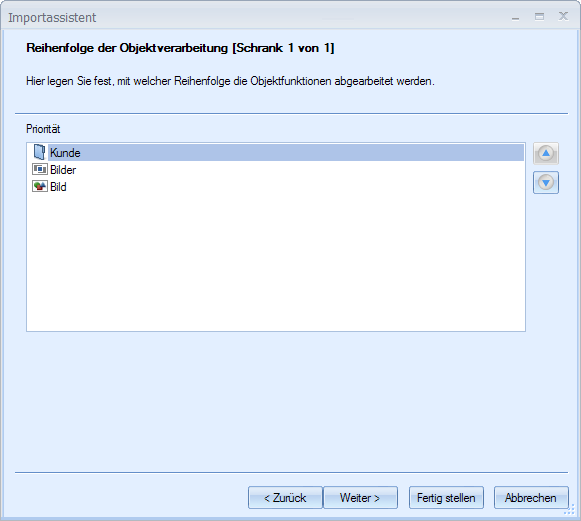Object Actions and Order
You can specify the object actions to be executed for every object type with search fields in case exactly one hit, multiple hits, or no hit was found.
If you configure multiple object types with search fields, specify in which order objects will be searched.
New index data record, and thus new objects, are created without search fields.
If version control is activated for those object types that serve as the import target, the data replaced during an update are retained, and can be viewed or restored using the editing history.
Object Actions
The Object actions dialog follows every mapping dialog in which you have configured search fields.

Action for one hit:
-
Do not import the active record into this cabinet
No objects are created or updated by the current record in the current cabinet.
-
Insert a new active variant of the hit
The new document is stored as an active variant of the retrieved document. This option is only available for W-Documents or module-spanning W-Documents.
-
Insert as a new inactive variant of the hit
The new document is stored as an inactive variant of the retrieved document. This option is only available for W-Documents or module-spanning W-Documents.
-
Update index data
Index data of the retrieved object will be updated with import data.
-
Do not update object data
Neither index data nor document files are updated for the found object.
-
Execute master insert
If the found object is a document without pages, index data will be updated and the file assigned.
If the located object is a document with pages, a new document will be created at the same location.
-
Create new index data record
A new object with the index data of the import record is created at the retrieved location.
-
Generate error message
No hit is used and an error message is produced.
Action when there are multiple hits:
-
Do not import the active record into this cabinet
No objects are created or updated by the current record in the current cabinet.
-
Update all hit objects
All hits are updated.
-
Execute "When there is one hit or a known location" action with first hit
The first hit will be taken and the action specified there will be executed.
-
Generate error message
No hit is used and an error message is produced.
-
Update index data of the first hit object
The first hit's index data will be updated using the import data.
-
Execute no action
No action will be taken for this object type.
-
Delete copies
This option assumes that more than one identical and empty folder or document without pages was found. Then, only one object will be retained.
-
Create new index data record (location of first hit object)
A new object with data from the import record is created at the location of the first hit object.
Action for no hit:
-
Do not import the active record into this cabinet
Neither a new object will be created, nor will an existing object be updated.
-
Link first different hit to the current location
This action applies when you want to import documents and a new location has already been determined at which there is a document of the same type and index data. Then, a reference copy is created at the current location. Reference copies are documents with identical index data and the same document file, and have different filing locations from which they can be edited equally.
-
Generate error message
The record will be flagged as corrupt. The import process will continue with the next record.
-
Execute no action
No action will be taken for this object type.
-
Create new index data record
A new object with the index data of the import record is created. The location will also be specified using the data from the index record.
For each case you will have to define whether or not to execute the Next action. The next action is the search for objects in the order of object processing within a cabinet.
Also specify whether to include Search fields. If search fields are included, the index data of search fields will also be updated.
Order of Object Processing
If you configure multiple objects types with search fields, you specify an action for each object type, and also enter the order in which the searches and the evaluation of the assigned object actions take place.
Enter for every cabinet the order of object processing if you configure multiple object types with search fields in multiple cabinets.

The object actions for the objects that are in the first places on the list are executed first.
The object action is formed by combining searches if the order is 'folder/register/document'. If, for example, a folder is found, the following register search is limited to the root level of this folder. Similarly, if a register is found, the following document search will be limited to the root level of this register.
If the order is 'folder/registerA/registerB/document', register 'A' is searched then register 'B' after the folder search. If register 'B' is found, the corresponding object action has higher priority than the object action associated with register 'A'. Searches for register 'A' and register 'B' thus are not combined, that is, no search for register 'B' in register 'A' takes place.
If the order is 'document/folder', first documents are searched and the appropriate object action is executed. If there you have specified for 'No hit – Create new index data record' and no hit was returned, the location of the document is determined by the folder object action. If a hit was returned, the following folder action can be used to update the index data of the folder in which the document lies.
 areas. Use the toolbar to show all hidden areas at once:
areas. Use the toolbar to show all hidden areas at once:
